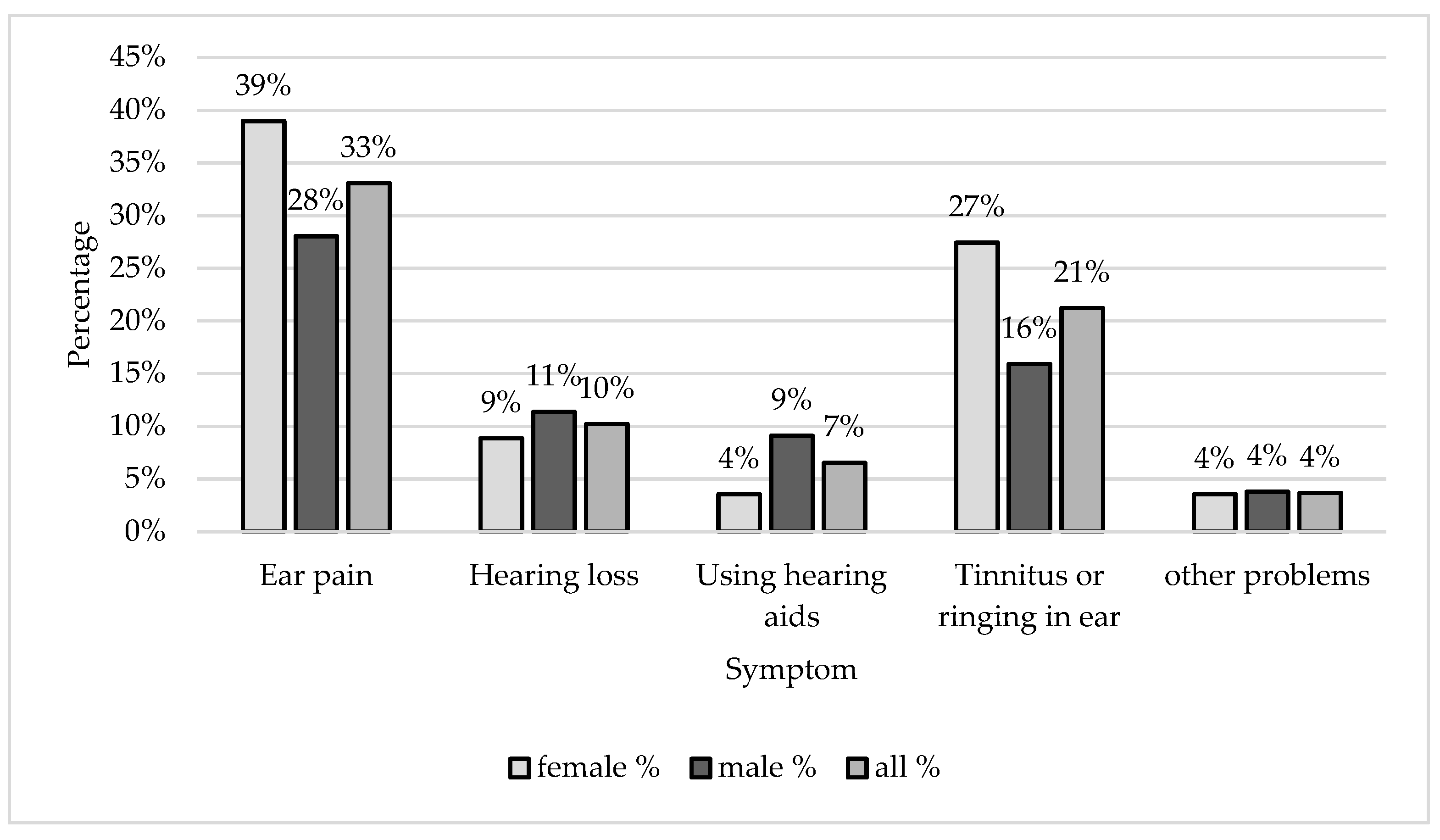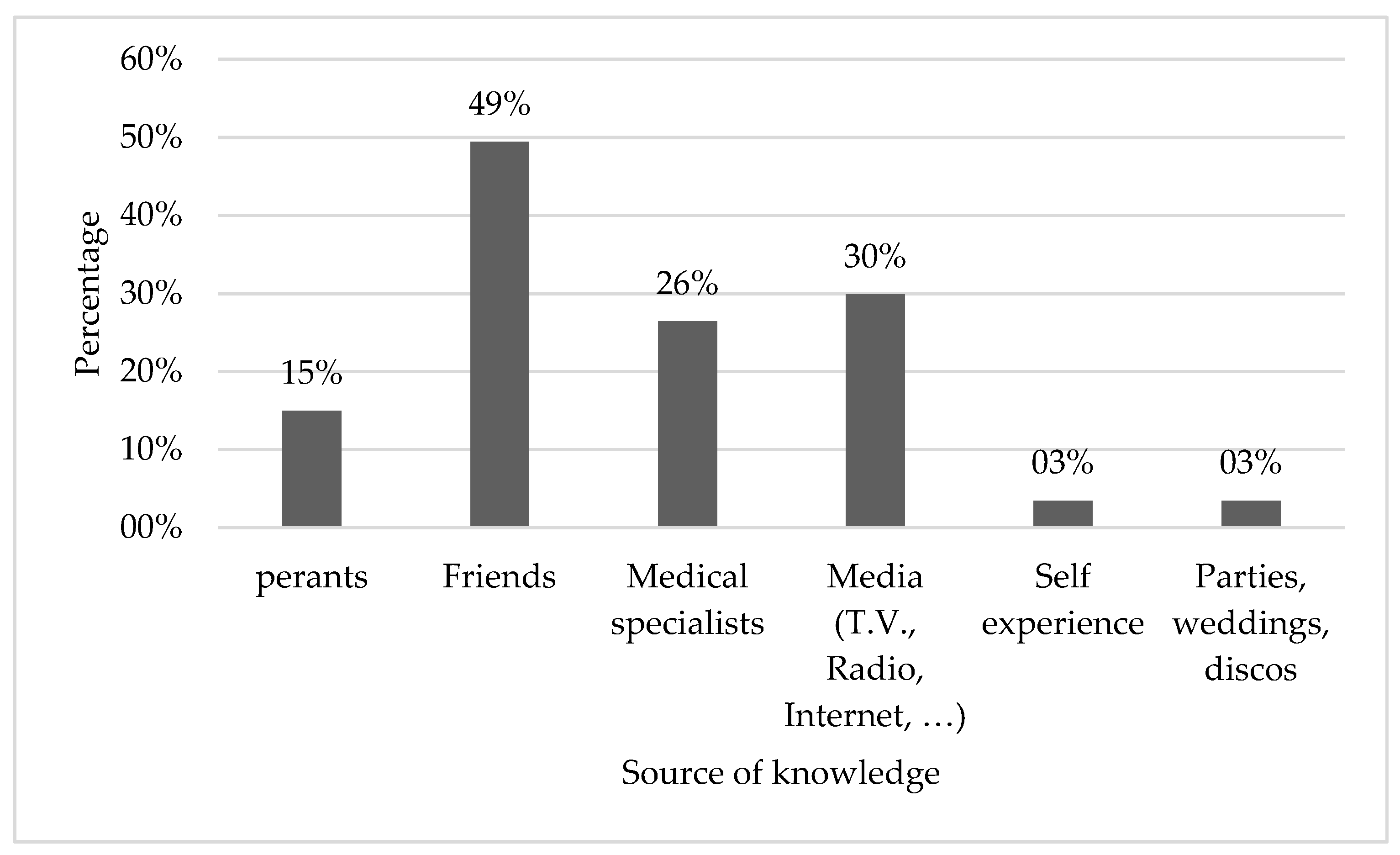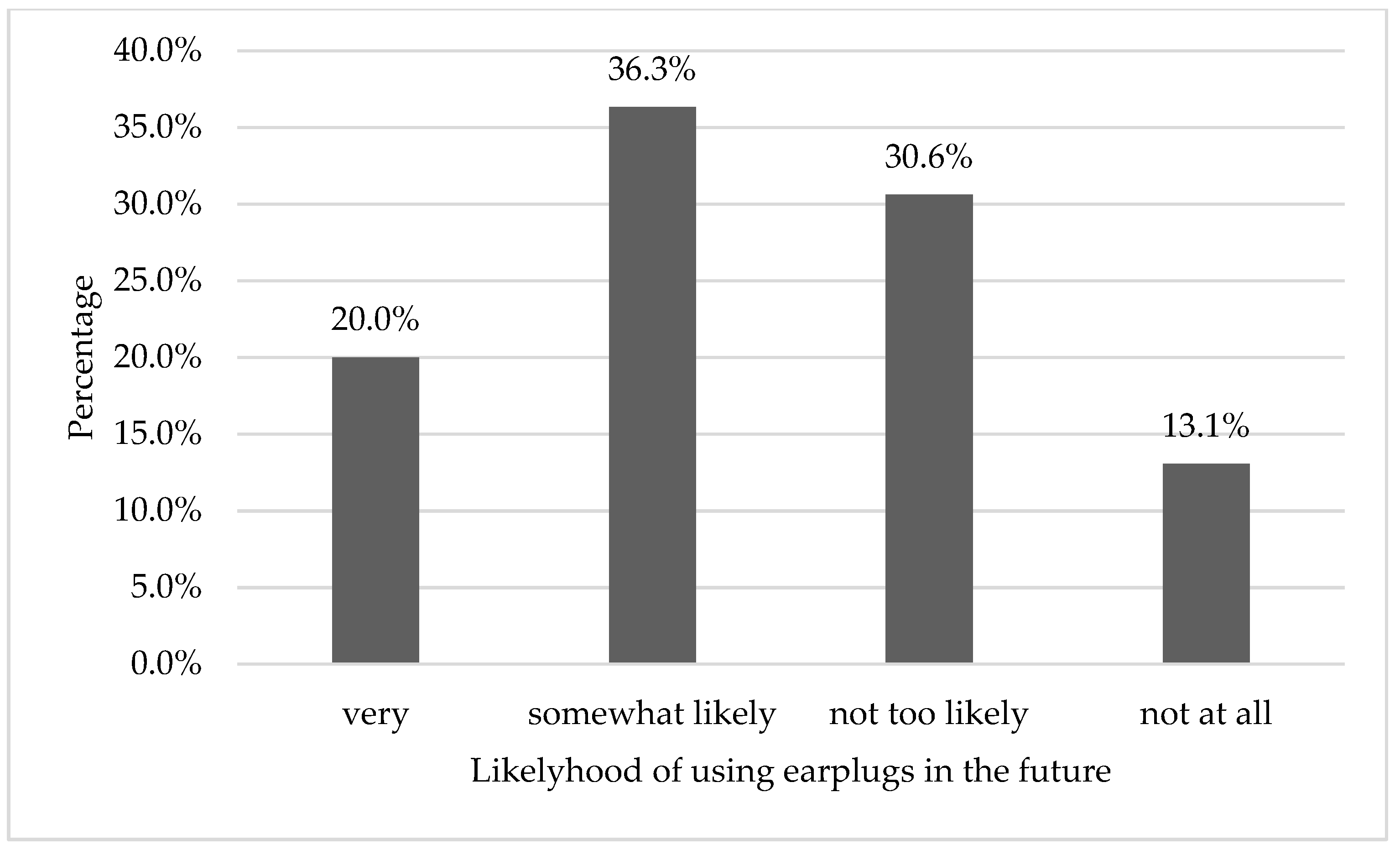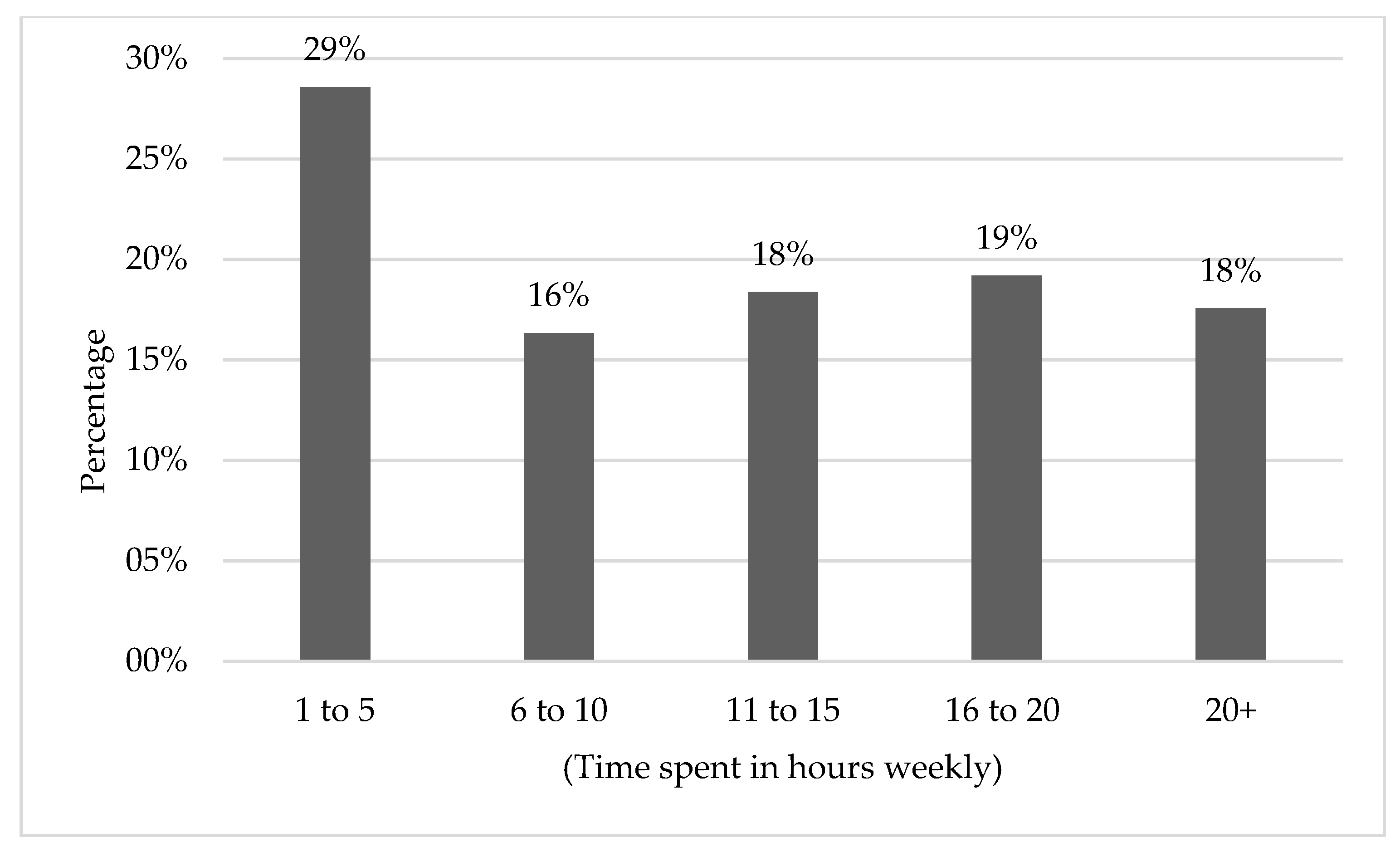Awareness of Noise-Induced Hearing Loss and Use of Hearing Protection among Young Adults in Jordan
Abstract
:1. Introduction
2. Methods
3. Results
The Use of Hearing Protection
4. Discussion
5. Conclusions
Author Contributions
Funding
Acknowledgments
Conflicts of Interest
Appendix A
| A very Big Problem | A Big Problem | Not that Big | Not at All | |
| Hearing loss or hearing problems | ||||
| Depression |
| A very Big Problem | A Big Problem | Not that Big | Not at All | |
| Hearing loss or hearing problems | ||||
| Depression |
| Yes | No | How many times in a week/year? | |
| Listening to loud music on a stereo/headset, others | |||
| A club, rave and discos | |||
| Concerts | |||
| weddings and parties (with loud music) |
| Very often | Often | Not often | Never | |
| Listening to loud music on a stereo/headset | ||||
| During or after going to a disco, club, … | ||||
| During or after going to a concert | ||||
| During or after going to weddings and parties (with loud music) |
References
- World Health Organization. Prevention of Blindness and Deafness: Global Estimates on Prevalence of Hearing Loss. Available online: https://www.who.int/pbd/deafness/estimates/en/ (accessed on 4 June 2019).
- World Health Organization. Prevention of Deafness and Hearing Loss 2017. WHA7.13, Agenda Item 15.8. Available online: http://apps.who.int/gb/ebwha/pdf_files/WHA70/A70_R13-en.pdf (accessed on 6 June 2019).
- Blackwell, D.L.; Villarroel, M.A. Tables of Summary Health Statistics for U.S. Adults: 2017 National Health Interview Survey (Table A-6). National Center for Health Statistics. Available online: http://www.cdc.gov/nchs/nhis/SHS/tables.htm (accessed on 6 June 2019).
- Dangerous Decibels. Noise Induced Hearing Loss (NIHL) 2018, A Public Health Partnership for Prevention of Noise-Induced Hearing Loss and Tinnitus. Available online: http://www.dangerousdecibels.org/education/information-center/noise-induced-hearing-loss/ (accessed on 1 July 2019).
- Action on Hearing Loss. Hearing Matters: Why Urgent Action Is Needed on Deafness, Tinnitus and Hearing Loss Across the UK 2015; Action on Hearing Loss: London, UK, 2015; Available online: https://www.actiononhearingloss.org.uk/how-we-help/information-and-resources/publications/research-reports/hearing-matters-report/ (accessed on 1 July 2019).
- Rabinowitz, P.M. Noise-induced hearing loss. Am. Family Phys. 2000, 61, 2749–2756. [Google Scholar]
- Olusanya, B.O.; Neumann, K.J.; Saunders, J.E. The Global Burden of Disabling Hearing Impairment: A Call to action. Bull. World Heal. Organ. 2014, 92, 367–373. [Google Scholar] [CrossRef] [PubMed]
- Phillips, S.L.; Henrich, V.C.; Mace, S.T. Prevalence of noise-induced hearing loss in student musicians. Int. J. Audiol. 2010, 49, 309–316. [Google Scholar] [CrossRef] [PubMed] [Green Version]
- Meyer-Bisch, C. Epidemiological Evaluation of Hearing Damage Related to Strongly Amplified Music (Personal Cassette Players, Discotheques, Rock Concerts) -High-definition Audiometric Survey on 1364 Subjects. Int. J. Audiol. 1996, 35, 121–142. [Google Scholar] [CrossRef]
- Dalton, D.S.; Cruickshanks, K.J.; Wiley, T.L.; E Klein, B.; Klein, R.; Tweed, T.S. Association of leisure-time noise exposure and hearing loss. Audiology 2001, 40, 1–9. [Google Scholar] [CrossRef]
- Morioka, I.; Luo, W.; Miyashita, K.; Takeda, S.; Wang, Y.; Li, S. Hearing impairment among young Chinese in a rural area. Public Heal. 1996, 110, 293–297. [Google Scholar] [CrossRef]
- Bogoch, I.; House, R.; Kudla, I. Perceptions about hearing protection and noise-induced hearing loss of attendees of rock concerts. Can. J. Public Heal. 2005, 96, 69–72. [Google Scholar]
- De Geest, S.; Corthals, P.; Vinck, B.; Keppler, H. Prevalence and characteristics of tinnitus after leisure noise exposure in young adults. Noise Heal. 2014, 16, 26–33. [Google Scholar] [CrossRef]
- Balanay, J.A.G.; Kearney, G.D. Attitudes toward noise, perceived hearing symptoms, and reported use of hearing protection among college students: Influence of youth culture. Noise Heal. 2015, 17, 394–405. [Google Scholar] [CrossRef]
- Joubert, K.; Sebothoma, B.; Kgare, K.S. Public awareness of audiology, hearing and hearing health in the Limpopo Province, South Africa. S. Afr. J. Commun. Disord. 2017, 64, 1–9. [Google Scholar] [CrossRef]
- Chung, J.H.; Roches, C.M.D.; Meunier, J.; Eavey, R.D. Evaluation of Noise-Induced Hearing Loss in Young People Using a Web-Based Survey Technique. Pediatrics 2005, 115, 861–867. [Google Scholar] [CrossRef] [PubMed] [Green Version]
- Quintanilla-Dieck, M.D.L.; Artunduaga, M.A.; Eavey, R.D. Intentional Exposure to Loud Music: The Second MTV.com Survey Reveals an Opportunity to Educate. J. Pediatr. 2009, 155, 550–555. [Google Scholar] [CrossRef] [PubMed]
- Ryder, T.; Sadhra, S.; Jackson, C.A.; Brown, M.J. Noise Exposure and Hearing Loss among Student Employees Working in University Entertainment Venues. Ann. Occup. Hyg. 2002, 46, 455–463. [Google Scholar] [Green Version]
- Beach, E.F.; Gilliver, M.; Williams, W. A snapshot of young adults’ noise exposure reveals evidence of ‘Binge Listening’. Appl. Acoust. 2014, 77, 71–75. [Google Scholar] [CrossRef]
- Brug, J.; Raat, H.; Vogel, I.; Van Der Ploeg, C.P.B. Strategies for the Prevention of MP3-Induced Hearing Loss Among Adolescents: Expert Opinions from a Delphi Study. Pediatrics 2009, 123, 1257–1262. [Google Scholar]
- Johnson, O.; Andrew, B.; Walker, D.; Morgan, S.; Aldren, A. British university students’ attitudes towards noise-induced hearing loss caused by nightclub attendance. J. Laryngol. Otol. 2014, 128, 29–34. [Google Scholar] [CrossRef] [PubMed]
- Lass, N.; Woodford, C.; Everly-Myers, D. A Survey of College Students’ Knowledge and Awareness of Hearing, Hearing Loss, and Hearing Health. NSSLHA J. 1989, 17, 90–94. [Google Scholar] [CrossRef]
- Holmes, A.E.; Erlandsson, S.; Carver, C.L.; White, L.L.; Widen, S.E. Perceived Hearing Status and Attitudes Toward Noise in Young Adults. Am. J. Audiol. 2007, 16, S182. [Google Scholar] [CrossRef]
- Widén, S.; Holmes, A.; Johnson, T.; Bohlin, M.; Erlandsson, S. Hearing, use of hearing protection, and attitudes towards noise among young American adults. Int. J. Audiol. 2009, 48, 537–545. [Google Scholar] [CrossRef]
- Archbold, S.; Lamb, B.; O’Neill, C.; Atkins, J. The Real Cost of Adult Hearing Loss: Reducing Its Impact by Increasing Access to the Latest Hearing Technologies 2014; The Ear Foundation: Nottingham, UK, 2014. [Google Scholar]
- Weichbold, V.; Zorowka, P. Effects of a hearing protection campaign on the discotheque attendance habits of high-school students: Efectos de una campaña de protección auditiva en los hábitos de asistencia a discotecas de estudiantes de educación media. Int. J. Audiol. 2003, 42, 489–493. [Google Scholar] [CrossRef]
- Gilles, A.; Paul, V.D.H. Effectiveness of a preventive campaign for noise-induced hearing damage in adolescents. Int. J. Pediatr. Otorhinolaryngol. 2014, 78, 604–609. [Google Scholar] [CrossRef]
- National Academy of Engineering Public Information on Noise Control. In Technology for a Quiter America; The National Academies Press: Washington, DC, USA, 2010; pp. 131–136.
- Blazer, D.G.; Domnitz, S.; Liverman, C.T. Hearing Health Care for Adults: Priorities for Improving Access and Affordability; The National Academies Press: Washington, DC, USA, 2016. [Google Scholar]
- Ministry of Environment, Jordan. Noise Reduction and Prevention Instructions. Issued Pursuant to Paragraph (d) of Article (4) of the Temporary Environmental Protection Law No. (1) for the Year 2003. Available online: http://moenv.gov.jo/AR/LegislationAndPolicies/Legislation/Instructions/Documents/Forms/AllItems.aspx (accessed on 4 June 2019).




| Characteristic | n | Percentage % |
|---|---|---|
| Gender | ||
| Male | 132 | 53.9 |
| Female | 113 | 46.1 |
| Age | ||
| 17–19 | 47 | 19.2 |
| 20–22 | 119 | 48.6 |
| 23 years and above | 79 | 32.2 |
| Educational level | ||
| Undergraduate | 207 | 84.5 |
| Graduate | 38 | 15.5 |
| Family Income | ||
| Above Average | 33 | 13.5 |
| Average | 93 | 38.0 |
| Below average | 18 | 7.3 |
| Don’t know | 60 | 24.5 |
| Prefer not to answer | 41 | 16.7 |
| Noisy Activity | Male (n = 132) | Female (n = 113) | p Value | x2 | ||
|---|---|---|---|---|---|---|
| n | % | n | % | |||
| Listening to loud music on a stereo/headset | 103 | 78.0% | 96 | 85.0% | 0.163 | 1.95 |
| Clubs, raves, and discos | 65 | 49.2% | 17 | 15.0% | <0.01 | 31.87 |
| Concerts | 76 | 57.6% | 54 | 47.8% | 0.126 | 2.34 |
| Weddings and parties (with loud music) | 93 | 70.5% | 101 | 89.4% | <0.01 | 13.16 |
© 2019 by the authors. Licensee MDPI, Basel, Switzerland. This article is an open access article distributed under the terms and conditions of the Creative Commons Attribution (CC BY) license (http://creativecommons.org/licenses/by/4.0/).
Share and Cite
Alnuman, N.; Ghnimat, T. Awareness of Noise-Induced Hearing Loss and Use of Hearing Protection among Young Adults in Jordan. Int. J. Environ. Res. Public Health 2019, 16, 2961. https://doi.org/10.3390/ijerph16162961
Alnuman N, Ghnimat T. Awareness of Noise-Induced Hearing Loss and Use of Hearing Protection among Young Adults in Jordan. International Journal of Environmental Research and Public Health. 2019; 16(16):2961. https://doi.org/10.3390/ijerph16162961
Chicago/Turabian StyleAlnuman, Nasim, and Talha Ghnimat. 2019. "Awareness of Noise-Induced Hearing Loss and Use of Hearing Protection among Young Adults in Jordan" International Journal of Environmental Research and Public Health 16, no. 16: 2961. https://doi.org/10.3390/ijerph16162961
APA StyleAlnuman, N., & Ghnimat, T. (2019). Awareness of Noise-Induced Hearing Loss and Use of Hearing Protection among Young Adults in Jordan. International Journal of Environmental Research and Public Health, 16(16), 2961. https://doi.org/10.3390/ijerph16162961





